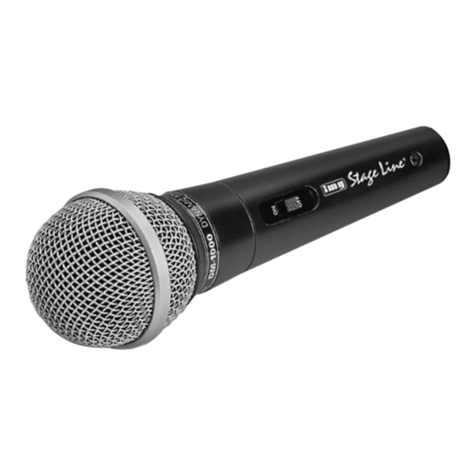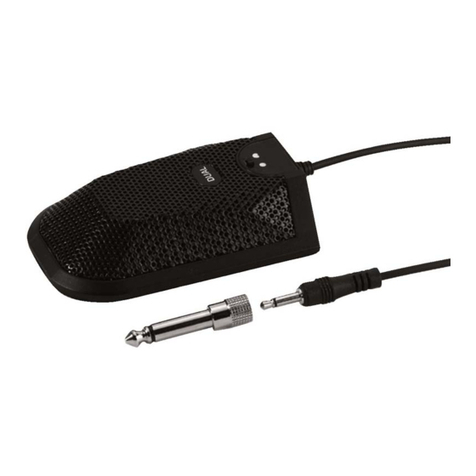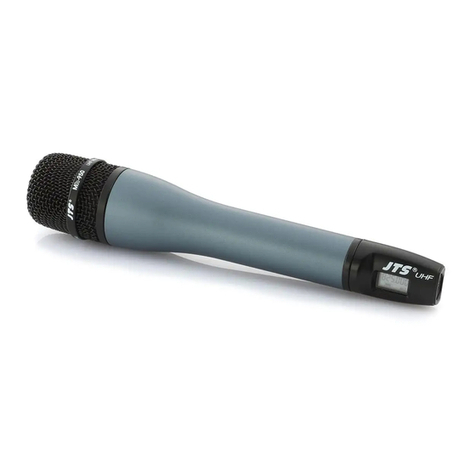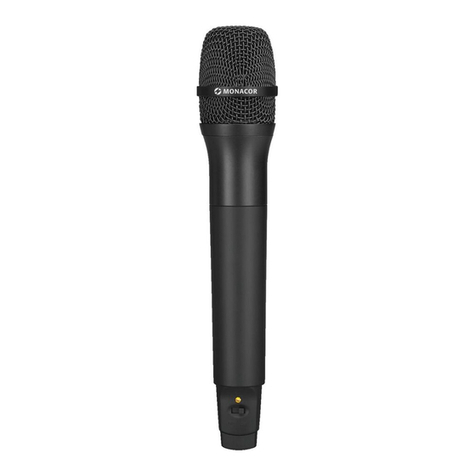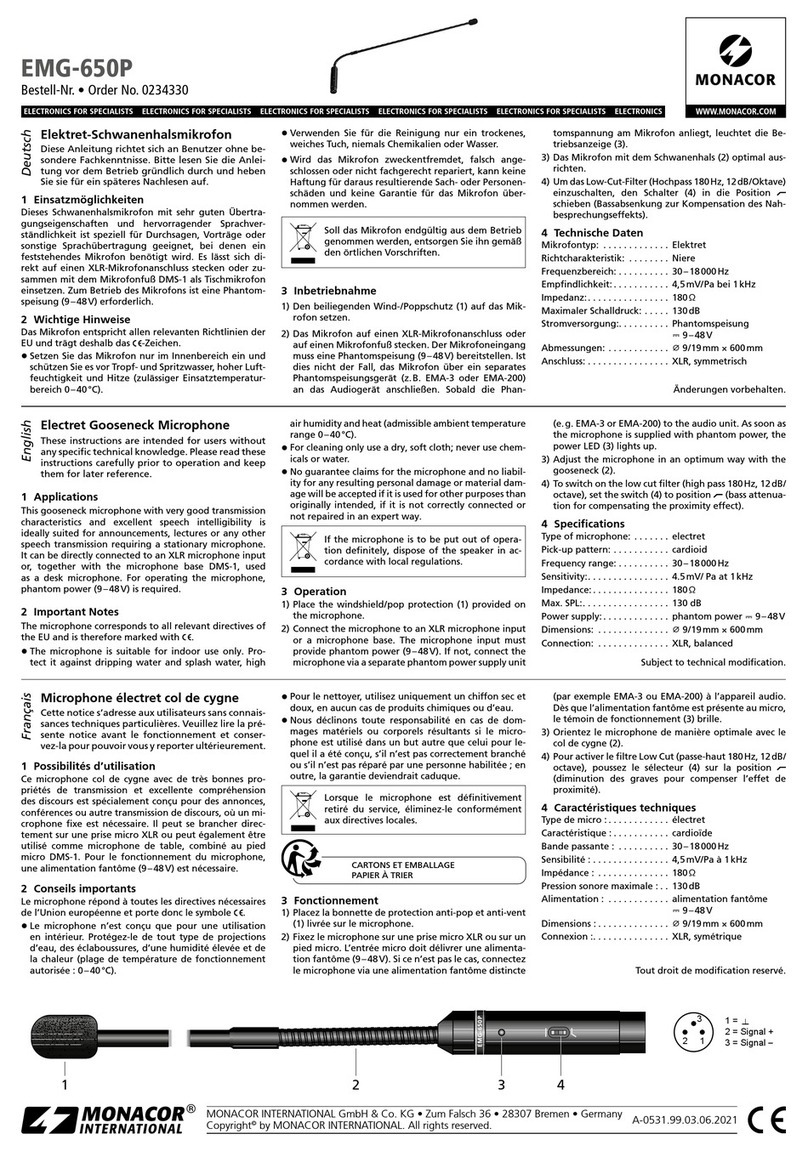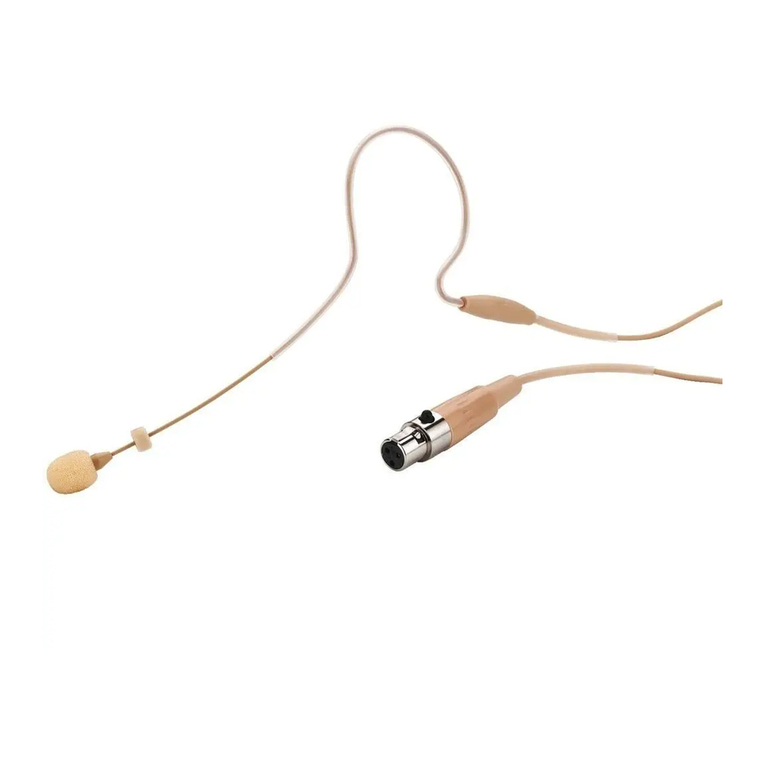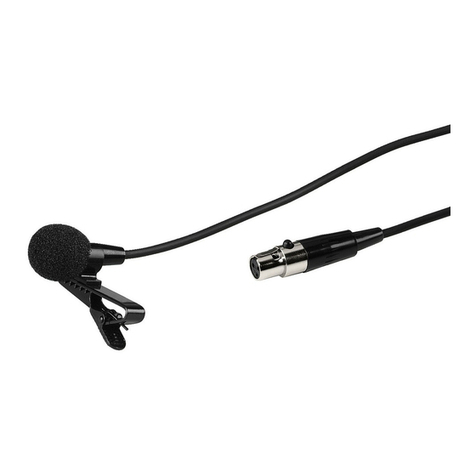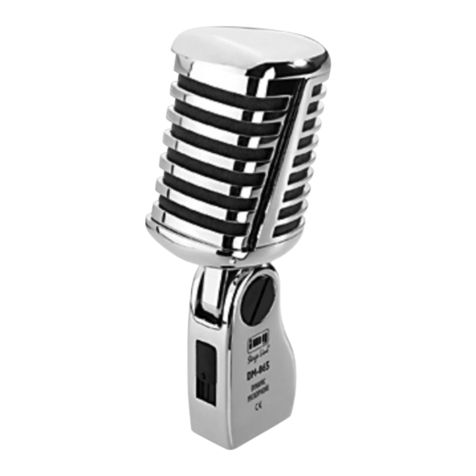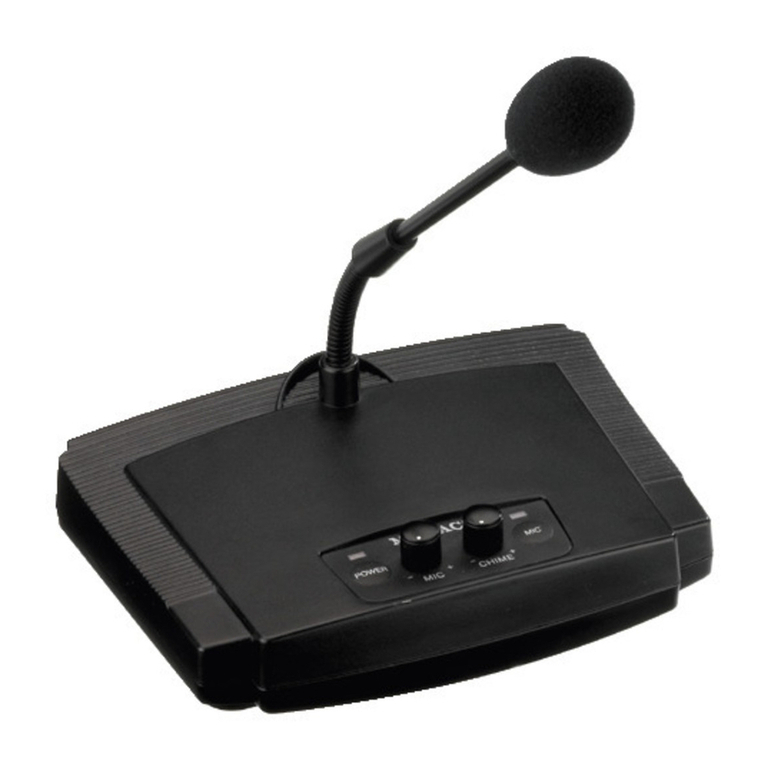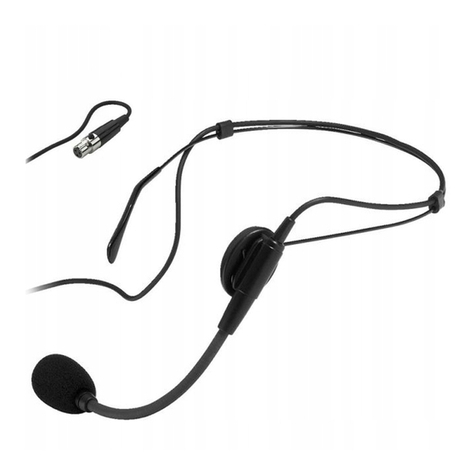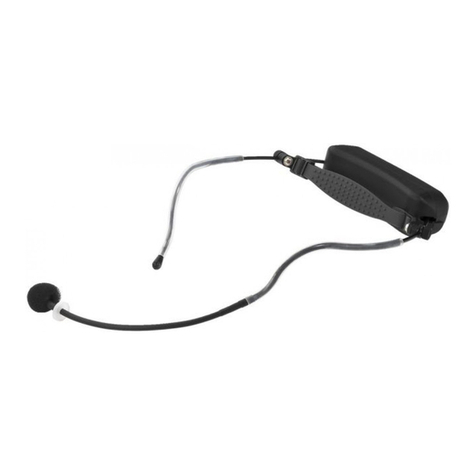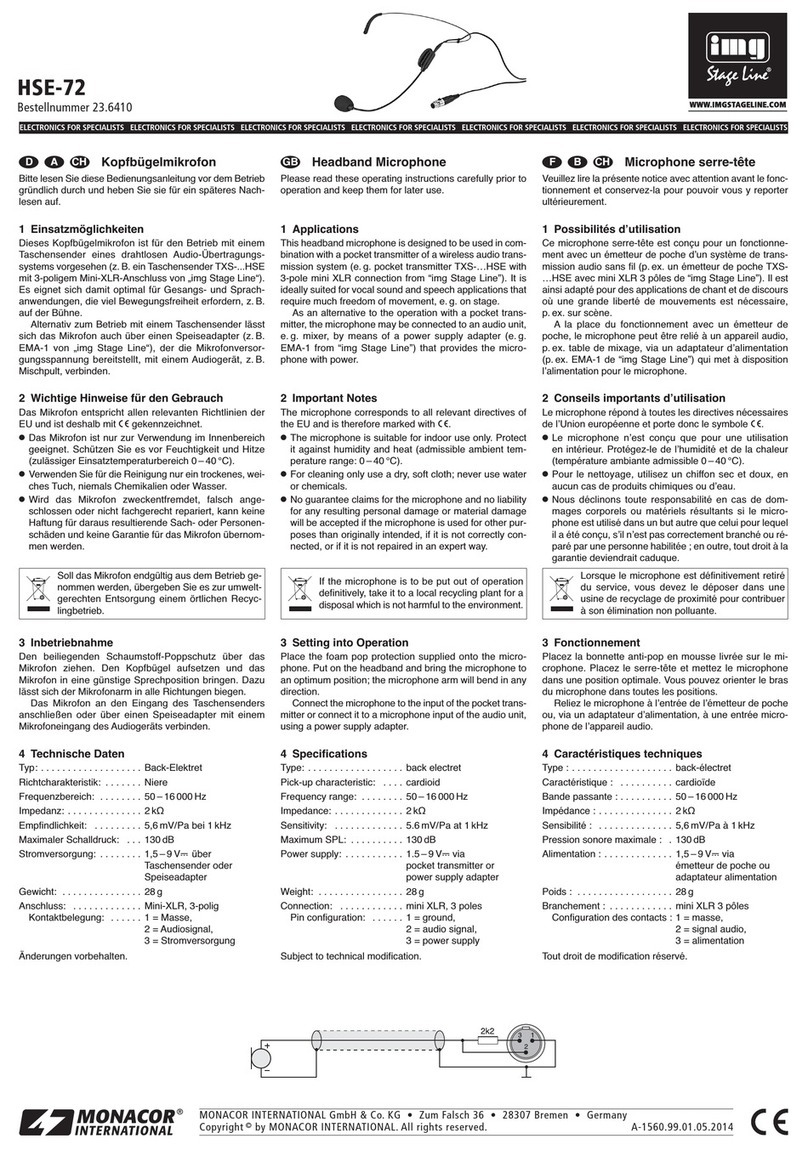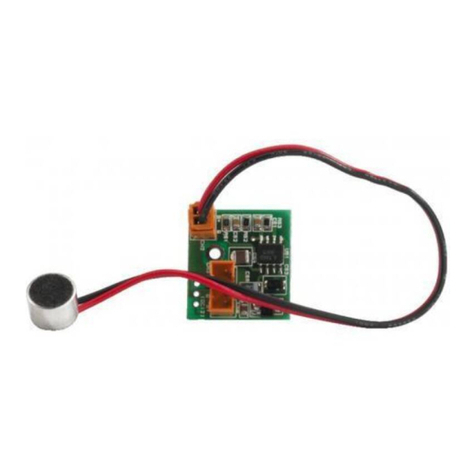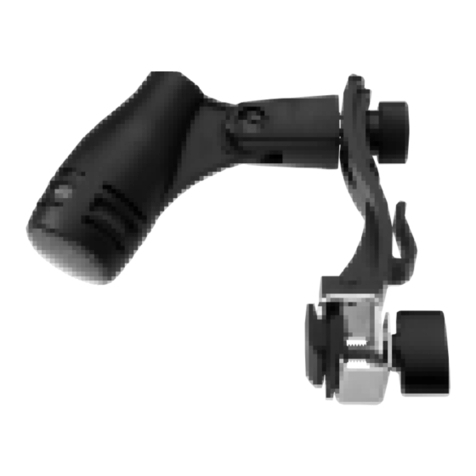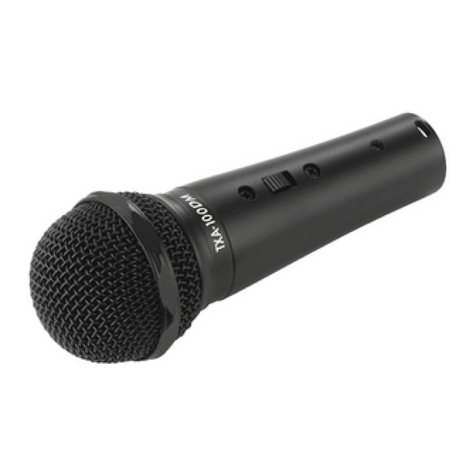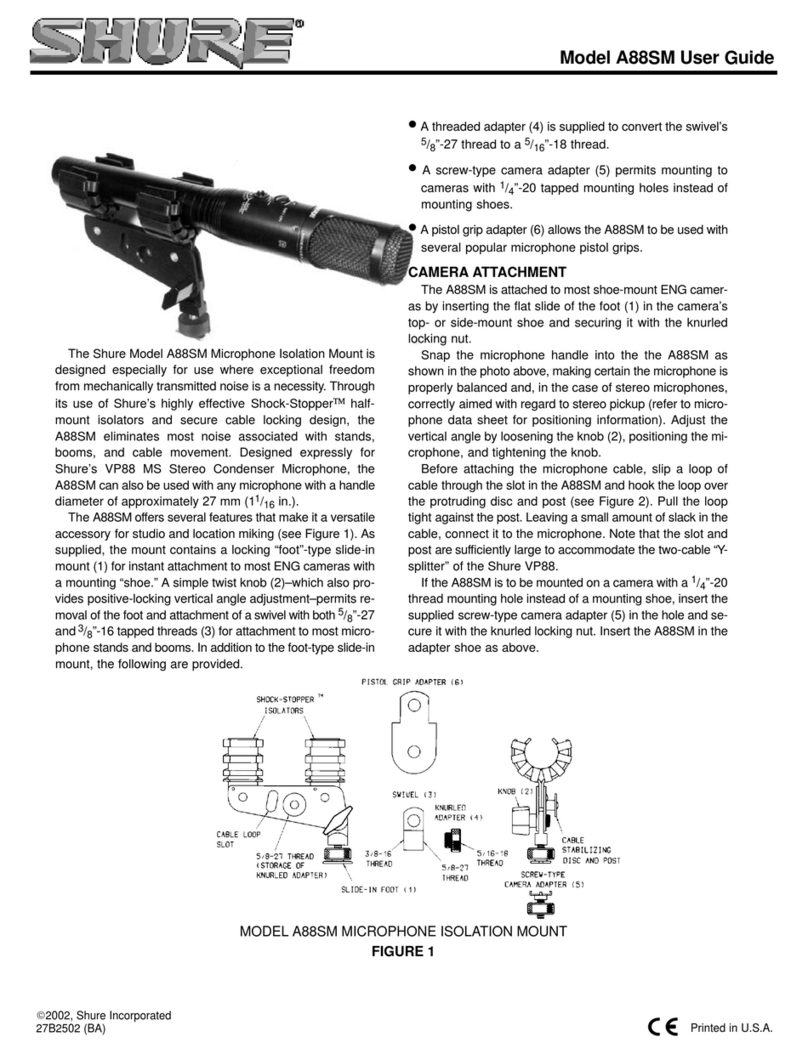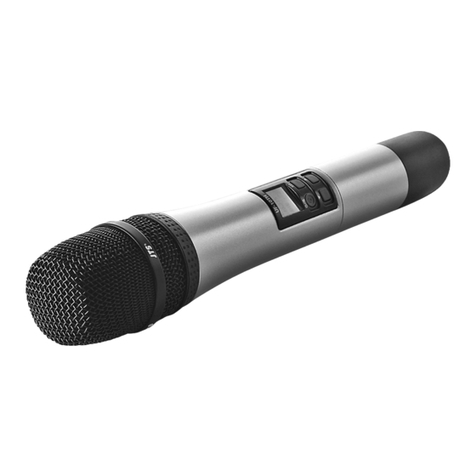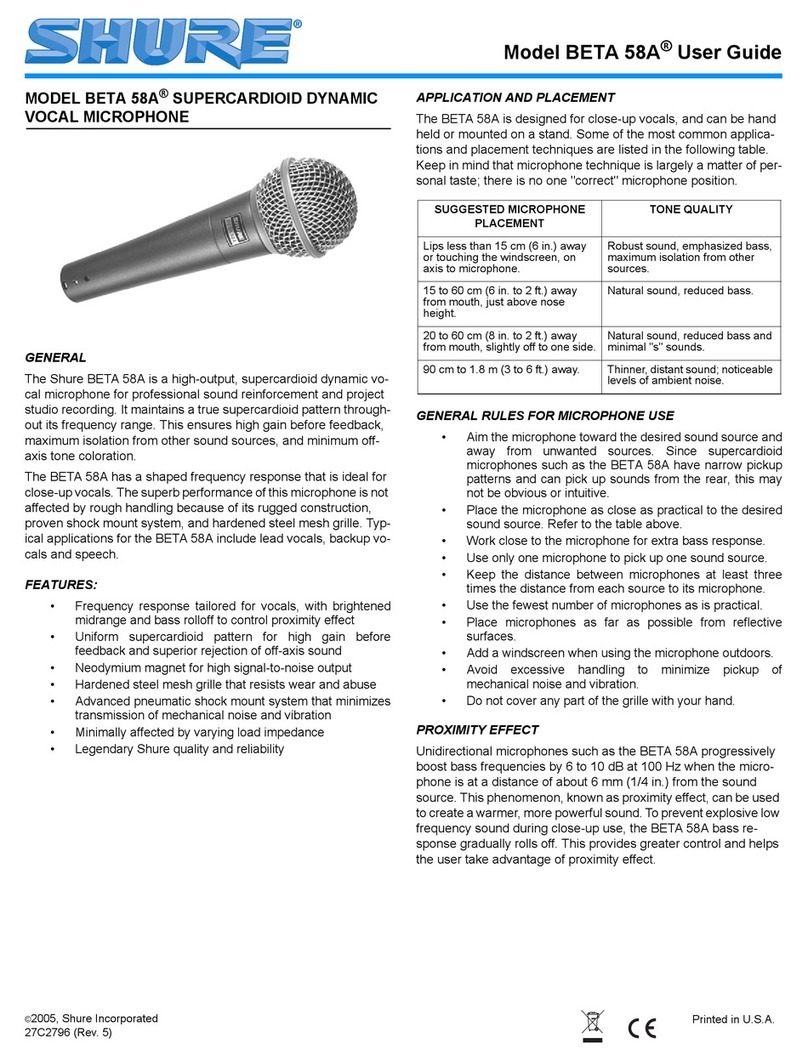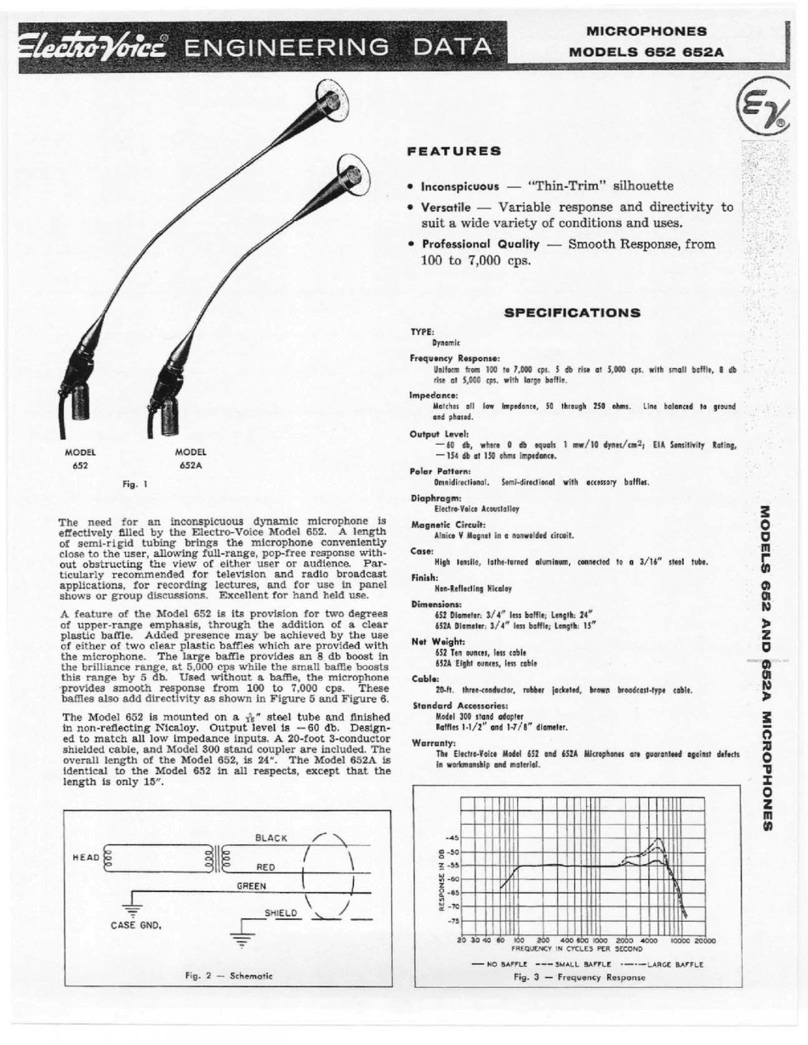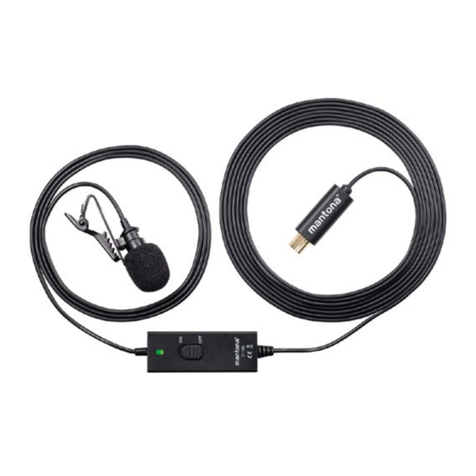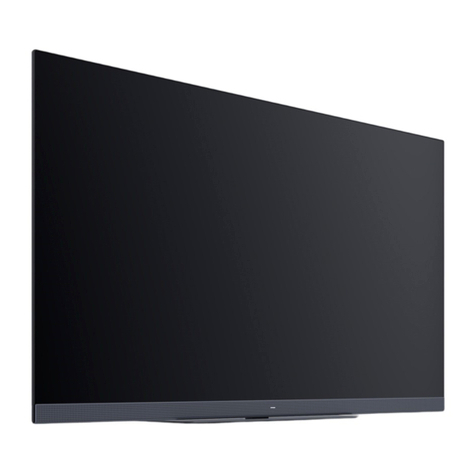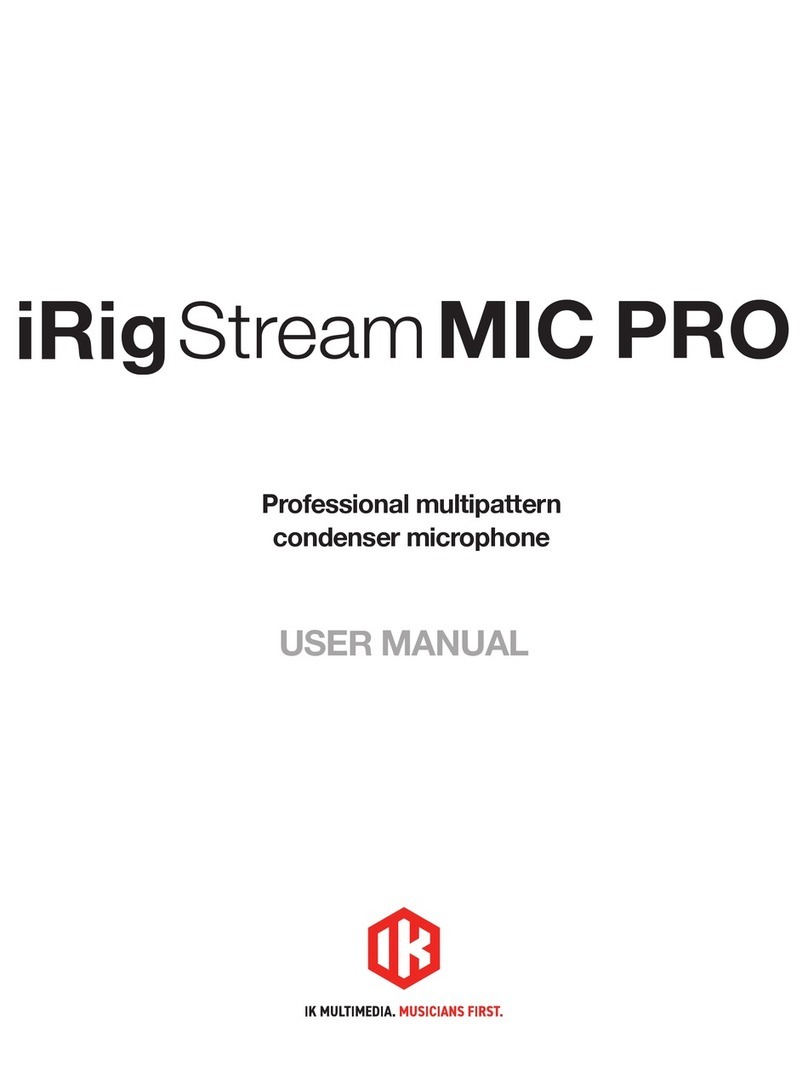wwwwww..iimmggssttaaggeelliinnee..ccoomm
Copyright©by MONACOR INTERNATIONAL GmbH & Co. KG, Bremen, Germany. All rights reserved. A-0509.99.01.11.2005
®
Microfono dinamico per
strumenti musicali
Vi preghiamo di leggere attentamente le presenti istruzioni prima
dell’uso e di conservarle per un uso futuro.
1 Possibilità d’impiego
I microfoni dinamici DM-44S e DM-44T sono stati rea-
lizzati per prelevare il suono dalla batteria e dagli stru-
menti di percussione e sono indicati specialmente per
snare-drum (DM-44S) e tom (DM-44T). Per mezzo dei
robusti clip possono essere fissati in modo semplice al
tamburo.
2 Avvertenze di sicurezza
Il microfono è conforme a tutte le direttive richieste
dell’UE e pertanto porta la sigla .
●Usare il microfono solo all’interno di locali. Proteg-
gerlo dall’umidità e dal calore (temperatura d’im-
piego ammessa fra 0 e 40°C).
●Perla puliziausare soloun pannomorbido, asciutto;
non impiegare in nessun caso prodotti chimici o
acqua.
●Nel caso d’uso improprio, di collegamenti sbagliati o
di riparazione non a regola d’arte del microfono non
si assume nessuna responsabilità per eventuali
danni consequenziali a persone o a cose e non si
assume nessuna garanzia per il microfono.
3 Messa in funzione
Allentareilgallettosulclip,bloccare ilsupportosulbordo
del tamburo e fissarlo bene stringendo il galletto. Per o-
rientareil microfonoversola sorgenteacustica allentare
la vite ad alette del supporto, posizionare il microfono
secondo i propri desideri e stringere di nuovo la vite.
Se si desidera eliminare il microfono defi-
nitivamente, consegnarlo per lo smalti-
mento ad un’istituzione locale per il
riciclaggio.
Collegare il microfono con l’ingresso microfono
dell’apparecchio audio usato (p.es. del mixer) ser-
vendosi di un cavo con presa XLR (p.es. della serie
MEC di “img Stage Line”).
4 Dati tecnici
Caratteristica
direzionale: . . . . . . . . . DM-44S: super cardioide
DM-44T: cardioide
Gamma di frequenze: . . 50–16000Hz
Sensibilità, impedenza
DMS-44S: . . . . . . . . . 1,6mV/Pa con 1kHz, 300 Ω
DMS-44T: . . . . . . . . 2mV/Pa con 1 kHz, 600 Ω
Pressione max. sonora: 130dB
Dimensioni, peso: . . . . Ø 42mm x 90mm, 185g
Collegamento: . . . . . . . XLR, simmetrico
Con riserva di modifiche tecniche.
Micrófono dinámico para
instrumentos
Por favor, lea atentamente estas instrucciones antes de la utiliza-
ción y guárdelas para usos posteriores.
1 Usos
Los micrófonos dinámicos DM-44S y DM-44T han
sido diseñados para recoger el sonido de batería y de
percusiones y son especialmente recomendables
para tambores (DM-44S) o tam-tams (DM-44T).Atra-
vés de su robusto soporte de abrazadera, los micró-
fonos pueden ser fácilmente montados en el tambor.
2 Notas importantes para su uso
El micrófono responde a todas las Directivas requeri-
das por la CEE y por ello está marcado con .
●Elmicrófono solo estáindicado para unuso en inte-
rior. Protéjalo de la humedad y del calor (tempera-
tura ambiente admisible: 0 –40°C).
●Para limpiar use sólo un paño seco y suave, no uti-
lice productos químicos o agua.
●No se asumirá ninguna garantía para el micrófono
ni se aceptará responsabilidad alguna en caso de
daños personales o materiales producidos si el
micrófono se usa con fines distintos a aquel para el
que fue fabricado, si no está correctamente conec-
tado, o si no es reparado de manera experta.
3 Funcionamiento
Suelte el tornillo de cabeza moleteada del dispositivo
de sujeción, sujete el soporte al borde del tambor, y
fíjelo ahí apretando el tornillo de cabeza moleteada.
Para ajustar el micrófono a la fuente de sonido, afloje
Si el micrófono es retirado del funcio-
namiento definitivamente, llévelo a un cen-
tro de reciclaje para su eliminación no con-
taminante para el medio ambiente.
el tornillo de mariposa del soporte, coloque el micró-
fono como desee, y vuelva a apretar el tornillo.
Conecteelmicrófono atravésdeun cablecontoma
hembra XLR (por ejemplo un cable de la serie MEC de
“img Stage Line”) a la entrada del micrófono de la
unidad audio utilizada (por ejemplo un mezclador).
4 Características técnicas
Sistema: . . . . . . . . . . . . DM-44S: supercardioide
DM-44T: cardioide
Banda pasante: . . . . . . . 50–16000Hz
Sensibilidad, impedancia
DMX-44S: . . . . . . . . . 1,6mV/Pa a 1kHz, 300Ω
DMX-44T: . . . . . . . . . 2mV/Pa a 1kHz, 600Ω
Presión sonora máxima: 130dB
Dimensiones, peso: . . . Ø 42mm x 90mm, 185g
Conexión: . . . . . . . . . . . XLR, simétrica
Sujeto a modificaciones técnicas.
Mikrofon dynamiczny do
instrumentów
Prosimy o uważne przeczytanie poniższej instrukcji przed użyciem
urządzenia, oraz o zachowanie tekstu do wglądu.
1Zastosowanie
Mikrofony dynamiczne DM-44S i DM-44T są przez-
naczone do zbierania dźwięków z perkusji oraz
instrumentów perkusyjnyc ; mikrofon DM-44S jest
idealny do werbli, natomiast DM-44T do tomów. Sta-
bilny uc wyt montażowy umożliwia łatwe przymoco-
wanie mikrofonu do instrumentu.
2Bezpieczeństwo użytkowania
Ponieważ urządzenie spełnia wymogi norm obowią-
zującyc w Unii Europejskiej, jest oznaczone symbo-
lem .
●Urządzenie przeznaczone jest do użytku tylko
wewnątrz pomieszczeń. Należy c ronić je przed
działaniem wilgoci oraz wysokiej temperatury
(dopuszczalna temperatura otoczenia pracy to
0–40ºC).
●Do czyszczenia urządzenia należy używać suc ej,
miękkiej tkaniny; nie wolno używać wody, ani c e-
micznyc środków czyszczącyc .
●Nie ponosi się odpowiedzialności za wynikłe usz-
kodzenia sprzętu lub obrażenia użytkownika w
przypadku, gdy urządzenie jest wykorzystywane w
innyc celac niż to się przewiduje, jeśli jest
niewłaściwie zainstalowane, lub poddane nieau-
toryzowanej naprawie.
3Przygotowanie do pracy
Należy poluzować śrubę radełkowaną przy uc wycie
montażowym, przymocować zacisk do krawędzi
instrumentu, następnie dokręcić śrubę. Aby ustawić
Jeśli urządzenie ma zostać ostatecznie
wycofane z użycia, należy przekazać je do
punktu utylizacji odpadów, aby uniknąć
zanieczyszczenia środowiska.
mikrofon w optymalnej pozycji, należy poluzować
drugą śrubę przy uc wycie montażowym, następnie
wyregulować położenie mikrofonu i dokręcić śrubę.
Należy podłączyć mikrofon do wejścia mikrofo-
nowego urządzenia audio (np. miksera) za pomocą
kabla z gniazdem nakablowym XLR (np. kabla z serii
MEC z oferty “img Stage Line”)
4Dane techniczne
C arakterystyka: . . . . . . DM-44S: superkardioida
. . . . . . . . . . . . . . . . . . . . DM-44T: kardioida
Pasmo przenoszenia: . . 50 – 16 000 Hz
Czułość, opór
DMX-44S: . . . . . . . . . 1,6 mV/Pa/1 kHz, 300 Ω
DMX-44T: . . . . . . . . . 2 mV/Pa/1 kHz, 600 Ω
Maks. SPL: . . . . . . . . . . 130 dB
Wymiary, waga: . . . . . . . Ø 42 mm x 90 mm, 185 g
Połączenie: . . . . . . . . . . XLR, sym.
Z zastrzeżeniem do możliwyc zmi.
DM-44S
Best.-Nr. 23.4170 DM-44T
Best.-Nr. 23.4180
I
E
PL
